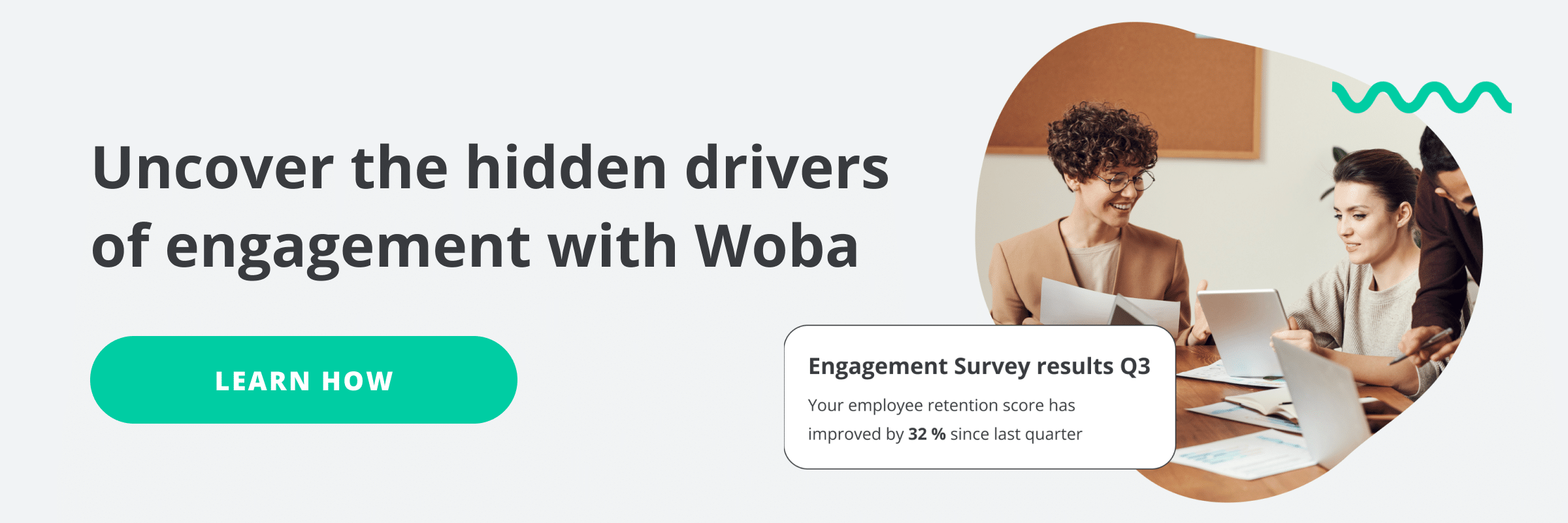As we all know by now, employee absenteeism can slowly eat away at an organization’s effectiveness and team performance. Whether it’s a pattern of frequent short-term absences or infrequent but longer ones, absenteeism is a big challenge for how well a company functions. It’s closely linked to an individual’s overall well-being.
Exploring Employee Absence and Its Relationship with Engagement
So, let’s dive into the connection between absenteeism and engagement and see how the HR department, armed with data, can tackle absenteeism trends within their organization. Absenteeism isn’t about pointing fingers or labeling people as lazy. It’s more about the work environment and what’s happening around it. And one of the first steps is to collect the right data to understand and pinpoint areas in the workplace that might cause unwanted absenteeism patterns and then take appropriate actions to overall improvement.
All of this is for the benefit of the company, the organization, the team, and, of course, the individual employee. That’s turning insights into real impact.
The Two Dimensions of Absence from Work
Absent employees are (super logically, we know) unable to fulfill the scope of their work role – either as an individual or as a team member of the organization. It’s no surprise that one unfortunate outcome of absenteeism is that the workload and departmental pressure often shift to other members of the organization.
Our main focus here isn’t to dwell on the well-covered negative consequences of absenteeism, as these have already been thoroughly discussed in HR research. Instead, our primary goal is to understand how absenteeism works in practical terms, specifically, identifying what drives this phenomenon. Getting a practical grasp of this is the crucial first step toward taking effective action.
Absenteeism related to frequency and duration
When it comes to employee absenteeism in general, there is already a clear distinction between frequency and duration.
High Frequency Signals Low Engagement and Motivation
Frequency refers to how often an employee calls in sick, regardless of how long they are absent. High frequency often indicates voluntary absence, which can be attributed to factors such as a lack of motivation or engagement, or as a psychological response to the work environment. In these cases, employees decide not to show up for work.
Voluntary absence is also linked to one of the main hypotheses in research known as the ‘withdrawal hypothesis’. This hypothesis suggests that employees actively seek to distance themselves (temporarily) from unpleasant work situations or conditions. These conditions may include a lack of autonomy, emotionally demanding situations, difficult relationships with immediate supervisors, or tasks that lack intrinsic interest. While there may be no physical barrier preventing employees from going to work, the presence of psychological factors such as low motivation, low engagement, or high burnout compels them to take protective actions, like staying home to ‘take a short break from high external demands. In such cases, absenteeism patterns typically exhibit higher frequency but shorter durations.
Duration is linked to health-related factors
Conversely, duration refers to the length of absenteeism and is often linked to health-related factors, such as actual sickness, like the flu or something more serious. This type of absence is typically labeled as involuntary. In cases of involuntary absence, your actual illness has made the decision for you – no matter how much you’d love to come in, how much you love your job and your co-workers, there’s simply no chance that you can make it out of bed!
And it happens to all of us – no one is immune to the flu, a bad meal, or anything in between. This pattern should result in medium-length durations and low frequency in terms of absence. When you’re out with the flu, you’re usually out for about a week, maybe two, once or twice a year.
What about when the absence duration becomes high?
But when absence duration shifts to high, we are looking into the second of the two main hypotheses; the stress-reaction hypothesis. The stress-reaction hypothesis relates to situations where employees have been exposed to numerous and frequent stressors over an extended period, leading to a devastating outcome – extended sick leave, much longer than what the withdrawal theory of absenteeism suggests. We might be talking about absences lasting for months…
So, in short, if your organization’s typical absenteeism pattern shows high frequency and low duration, it could be a result of an unfavorable working environment that needs to be addressed to prevent unnecessary sick leaves.
Without any action or initiatives, you may run the risk of absenteeism patterns shifting towards the stress-reaction scenario, resulting in much longer absences from your valued employees. The consequences for both the team and the organization in such a scenario need not be overstated. However, we would like to focus on the positive side of things, and yes, it’s all about work engagement!
So, why is measuring Engagement a good place to start?
We’ve previously discussed the various benefits of highly engaged employees in terms of their ‘output’ – they tend to be more productive, more inclined to collaborate, and more committed to the organization’s overarching goals and strategies.
However, it’s worth noting that engaged employees also exhibit higher overall motivation for work and report better overall health conditions. Studies have consistently found that engaged employees are significantly more present at work, with engagement showing a strong correlation with reduced absenteeism rates.
- Engaged employees may choose to be absent less frequently because they tend to approach their tasks in a self-determined manner, even in challenging work environments.
- Engaged employees report fewer psychosomatic complaints, such as headaches or chest pain, as well as fewer cardiovascular issues and less burnout-related fatigue.
- Engaged individuals rate both their overall health status and their ability to work more positively, and they are perceived as mentally healthier compared to their less engaged counterparts.
This may help explain why engaged employees don’t view work as exhausting and stressful, but rather as a positive challenge, making them less susceptible to stress-related health problems.
Conversely, less engaged employees appear to be less resilient in demanding work situations, leading them to withdraw more frequently and take more regular sick leave.
Predict and prevent absenteeism using Woba
Woba’s vision is to create a better world to work in by revolutionizing your HR landscape. We help HR departments and leaders worldwide in measuring, predicting, and taking action on the risk of talent loss and absenteeism.
Our passion lies in empowering you within HR to become the central driver of business impact. Using Woba, you can transform employee surveys into proactive action plans, measure the ROI of your initiatives, and align them with your most crucial HR KPIs.
Schedule a meeting with me to explore how Woba can help you prevent and predict absenteeism.













